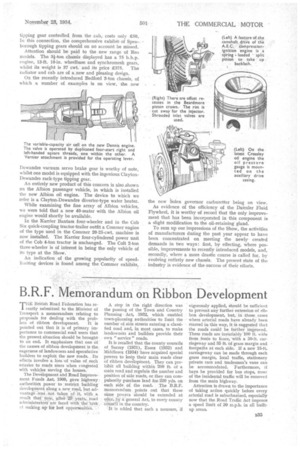B.R.F. Memorandum on Ribbon Development
Page 49

If you've noticed an error in this article please click here to report it so we can fix it.
THE British Road Federation has recently submitted to the Minister of Transport a memorandum relating to proposals for dealing with the prob lem of ribbon development. It is pointed out that it is of primary importance to commercial road users that the present situation should be brought tb an end. It emphasizes that one of. the causes of ribbon development is the. eagerness of landowners and speculative builders to exploit the new roads. Its effects involve a loss -of value of such arteries to roads users when congested with vehicles serving the houses. The Development and Road Improvement Funds Mt, 1909, gave highway authorities power to 'restrict building development along a.new.road, but advantage. WAS , not taken. of it with a result that now, after 25' yeats,, road administrators are faced with the ta-sk, el making up fok lost opportvnitieS. A step in the right direction was the passing of the Town. and Country Planning Act, 1932, which . enabled town-planning authorities to limit the number of side streets entering a' classified road and, in most cases, to make landowners and builders provide their own " service " roads.
It is recalled that the county councils of Surrey (1931), Essex (1932) and Middlesex (1934)Thave acquired special powers to keep their main roads clear of ribbon development. They can prohibit all building within 200 ft. of a main road and regulate the number and position of side roads, or they can compulsorily purchase land for 220 yds. on each side', of the road. • The B.R.F. memorandum points out that these same powers should be extended at once, by -a general Act, to every county CCtinieil in the country.
'It is added that such a measure, if vigorously applied, should be sufficient to prevent any further extension-of rib
bon development, but, -those, cases where arterial roads have already been marred•in-this way, it is suggested that the roads could be further improved. These roads are invariably' 100 ft. wide from fenCe to fence, with a 30-ft. carriageway and 85 ft. of grass margin and footpaths at each side. If a new 15-ft. carriageway can be made through each grass margin, local traffic, stationary private cars and tradesmen's vans can be accommodated. Furthermore, if bays be provided for bus stops, most of the incidental traffic will be removed from the main highway.
Attention is drawn to the importance of taking action quickly before every arterial road is suburbanized, especially now that the Road Traffic Act imposes a speed limit of 80 m.p.h. in all builtup areas.




























































































